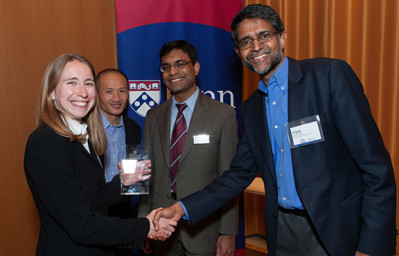
“She was so passionate about the her goal—utilizing TRHex to get students interested in STEM subjects. Her enthusiasm was infectious! She utilized an existing technology in a creative way, and she did a great job of communicating her idea and bringing the business to life.”
That’s how Michelle Proctor—Director of Innovation at FedEx, Mack Institute corporate partner, and Y-Prize Competition judge—describes prizewinner Emily Plumb. Below, Emily discusses what inspires her work and where she’s going next.
Was there anything when you were younger that particularly inspired your interest in STEM fields or set you on the path to becoming an engineer? (In other words, is there some version of TRHex in your past?)
I was an avid LEGO fan as a child and loved to build and design houses. Then, when I was in high school, I joined my all-girls engineering/robotics team. This was where I really got engaged in engineering, I found the “spark.” I loved learning about how mechanisms worked, how to actually design them and then build them. I’ve always loved to build and it is one of the reasons I became a mechanical engineer.
Your passion and enthusiasm were very clear during your presentation. What continues to inspire and motivate you?
Over a couple of summers during college, I co-taught a two-week summer camp at a private school in Boston on LEGO Mindstorms. I loved to see how the kids interacted with the robots and learned how to program them. I wished I had had Mindstorms as a child and felt that it would be valuable for more kids to have access to summer programs like these.
When I worked at iRobot we had a program called SPARK where you could go to schools and give presentations about robots, their impact on your life, and what it means to be an engineer. I’ve always been motivated to share that engineering spark and get younger students interested too.
Have you ever done anything like the Y-Prize before? Were there any unexpected challenges that you had to address?
I have never done anything like this before. Having an idea is one thing, but actually putting it into action is quite another. EduBot was the Kod*Lab’s first educational robot prototype, designed and built about five years ago, but the robot never took off. The idea of a hexapod teaching robot was one of the things that drew me to learning more about the Kod*Lab when I came to Penn.
I determined that the key to creating something successful would be to understand where EduBot had fallen short. Izzy [my Wharton Business Consultant] was incredibly helpful in taking the idea, the robot, and all the information I had gathered from teachers, then synthesizing the information into an engaging and feasible business model. There were many iterations and at each stage we learned something new that improved the concept.
What are the next steps for TRHex?
We will continue to show TRHex at schools and talk to more teachers to get our name out there and generate interest. Since the Y-Prize, TRHex has made an appearance at the Clark Park Science Festival in Philadelphia and will soon be at an elementary school science fair. Curriculum development is our next big challenge. We have started to fine-tune what the distribution method needs to be to make it most accessible in all classrooms.
Previously: Head judge Tom Fitzsimons on what made TRHex stand out. Wharton Business Consultant Isabelle Park and Technology Consultant Gavin Keneally on the joys and challenges of cross-disciplinary collaboration.



